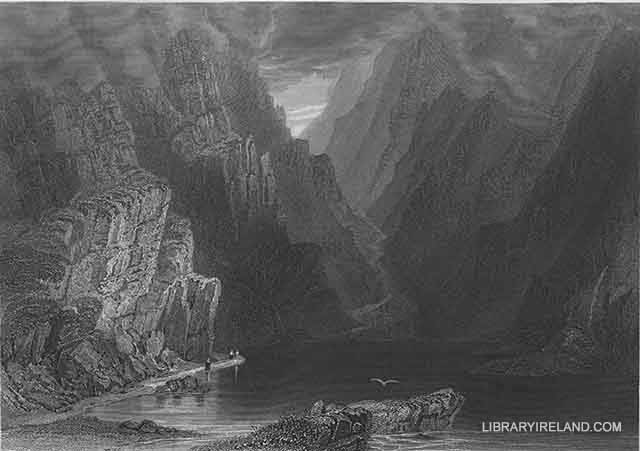Gap of Dunloe, County Kerry
The GAP OF DUNLOE, which I next visited, is a wild mountain defile or pass, lying between the Reeks and the Purple Mountain, a shoulder of the Tomies range. The glen, which is about four miles in length, presents a most extraordinary appearance. On either hand, the craggy cliffs, composed of huge masses of projecting rocks, impend fearfully over the narrow pathway, and at every step threaten with destruction the adventurous explorer of this desolate scene. In the interstices of these immense fragments, a few shrubs and trees shoot out in fantastic shapes, which, with the dark ivy and luxuriant heather, contribute to the picturesque effect of the landscape. A small, but rapid stream, called the Loe (from whence the name of the ravine), traverses the whole length of the glen, expanding itself at different points into five small lakes, each having its own proper name, but which are known in the aggregate as the Cummeen Thomeen Lakes. The road, which is a mere rugged footpath, constructed on the frequent brink of precipices, follows the course of the stream, and in two instances crosses it by means of bridges. One of these stands at the head of a beautiful rapid, where the water rushes in whitening foam over the rocky bed of the torrent. The part of the glen which attracts most admiration is that where the valley becomes so contracted as scarcely to leave room between the precipitous sides for the scanty pathway and its accompanying strand. The peasantry have given to this romantic pass the name of "the Pike."
Keeping onward, the visitor begins to ascend the Purple Mountain until he reaches an elevated point, from whence he obtains a sudden view of the Upper Lake, and the rich scenery in its neighbourhood. Beautiful, surpassingly beautiful, is the prospect before us! "On our right," says Mr. Windele, in describing it, "lies the deep, broad, desolate glen of Coomduv; an amphitheatre buried at the base, and hemmed in by vast masses of the mountain, whose rugged sides are marked by the courses of the descending streams. At the western extremity of the valley, gloomily reposes amidst silence and shadows one of those lakes, or rather circular basins, of dark, still waters, Loch an bric dearg, 'the lake of the charr or red trout.' Other lesser lakes dot the surface of the moor, and, uniting, form at the side opposite the termination of the gap, a fine waterfall of considerable height, enjoying the advantage not common to other falls in Ireland, of being plentifully supplied with water at every season of the year."

